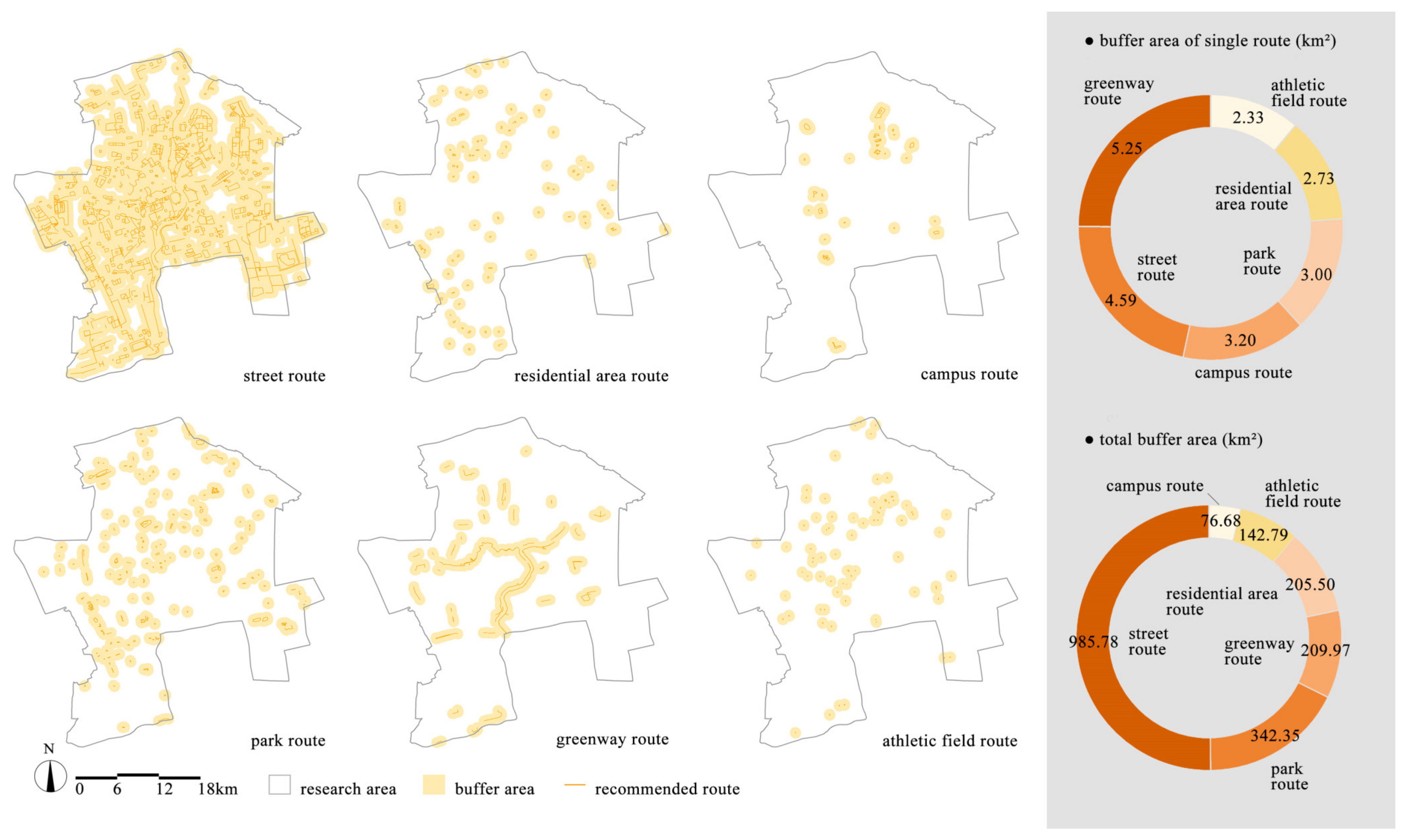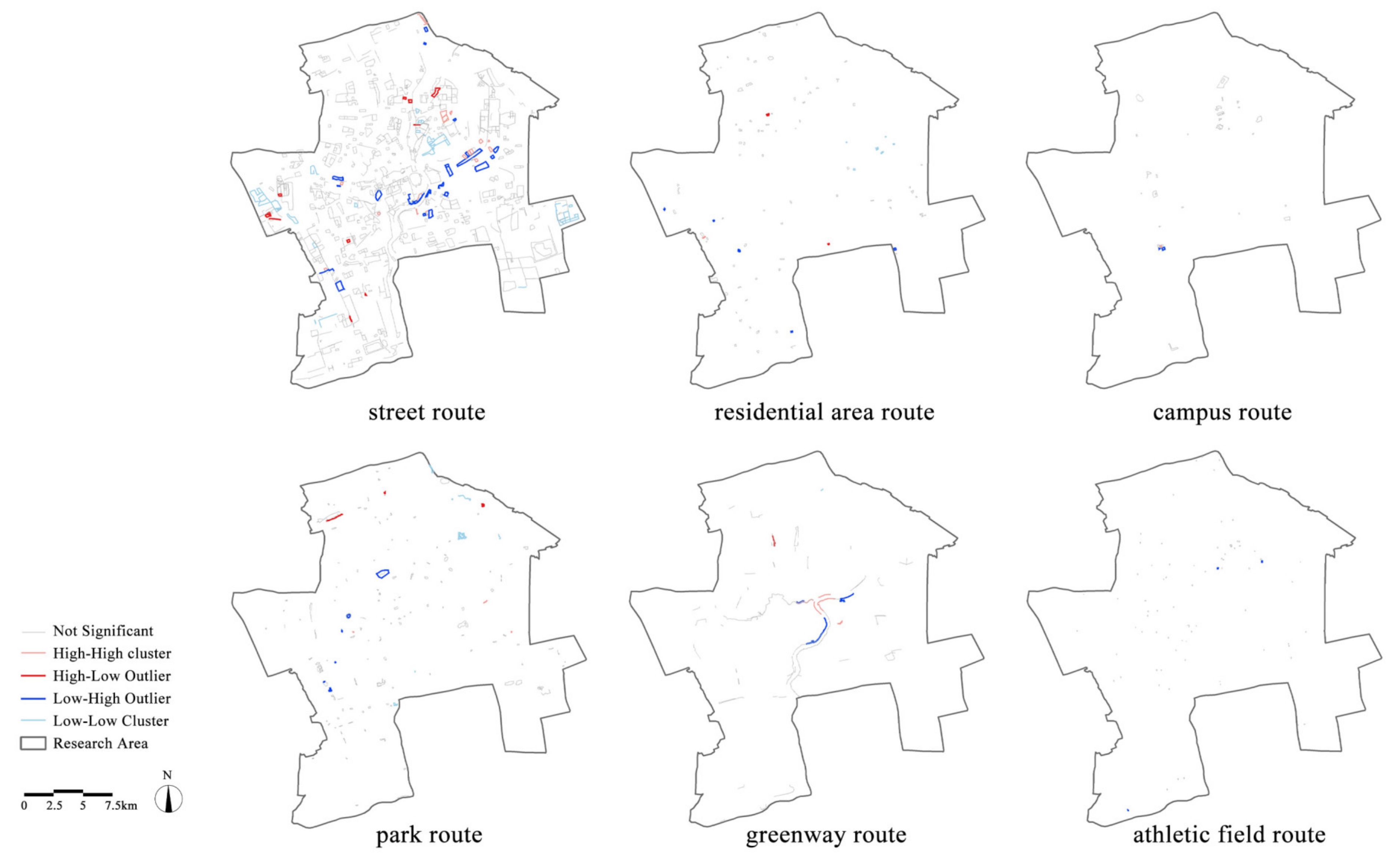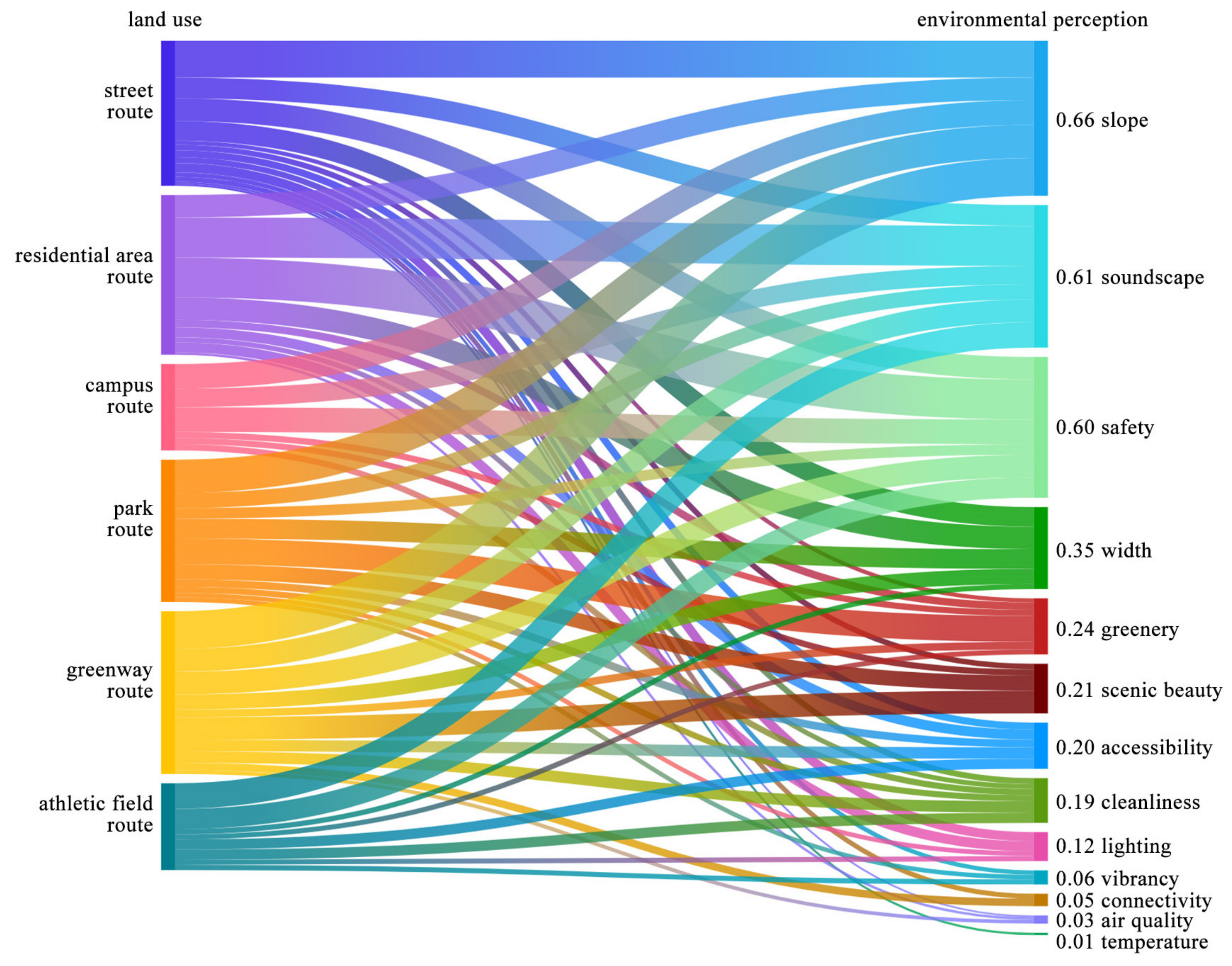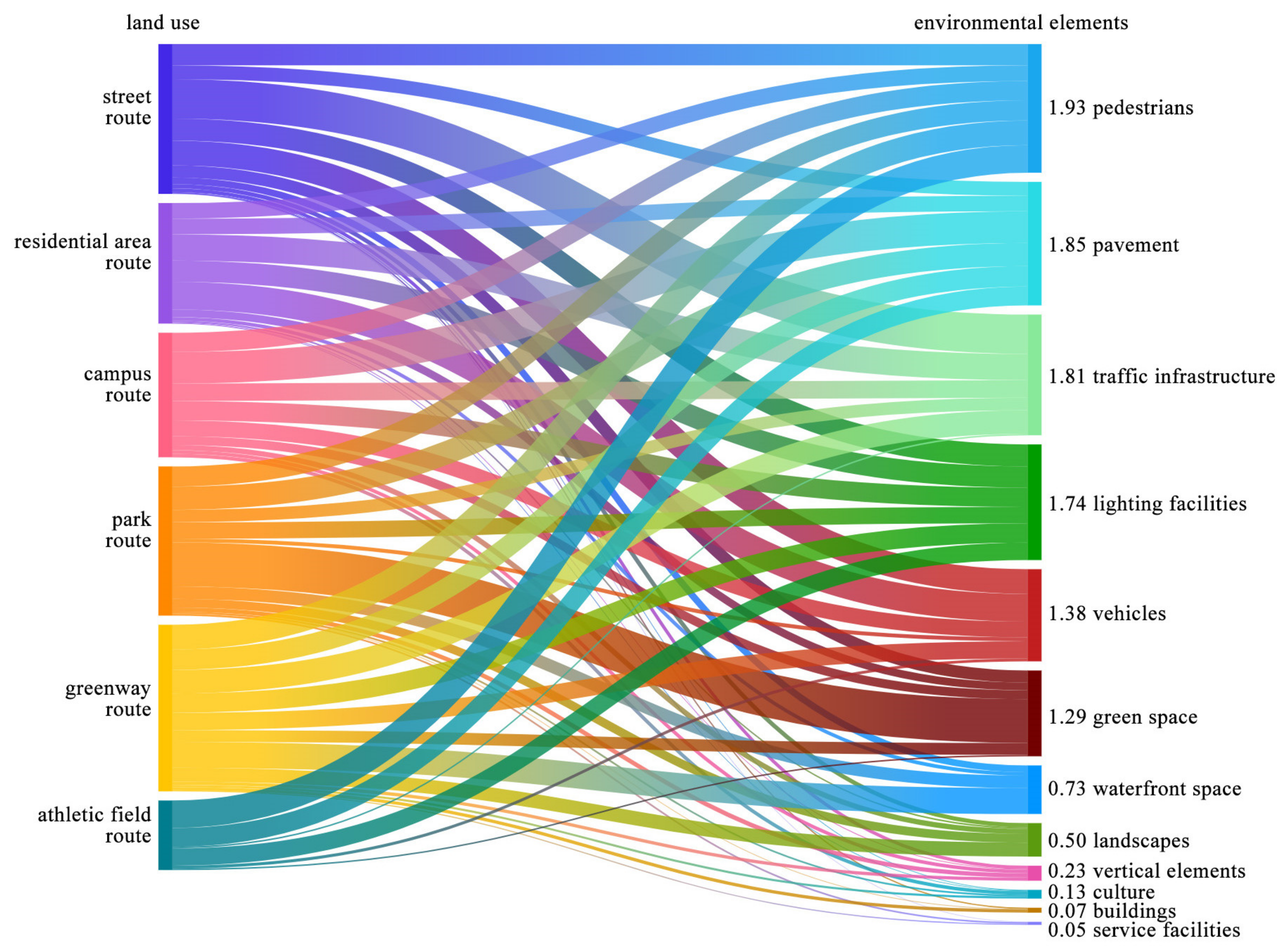Comparing Differences in Jogging Support across Various Land Use Types in Urban Built-Up Areas Using User-Recommended Routes
Abstract
1. Introduction
2. Materials and Methods
2.1. Research Framework
2.2. Data Sources and Land Use Types Classification
2.3. Spatial Analysis
2.4. Text Analysis
3. Results
3.1. Scale Differences
3.2. Spatial Differentiation
3.3. Environmental Perception
3.4. Environmental Elements
4. Discussion
4.1. Spatial Potential
4.2. Environmental Preference
4.3. Limitations and Future Perspectives
5. Conclusions
Author Contributions
Funding
Data Availability Statement
Acknowledgments
Conflicts of Interest
References
- Sun, P.; Zhao, H.; Lu, W. How urban environments affect public sentiment and physical activity using a cognitive computing framework. Front. Archit. Res. 2024, in press. [Google Scholar] [CrossRef]
- Feng, J.; Glass, T.A.; Curriero, F.C.; Stewart, W.F.; Schwartz, B.S. The built environment and obesity: A systematic review of the epidemiologic evidence. Health Place 2010, 16, 175–190. [Google Scholar] [CrossRef]
- Dorostkar, E.; Najarsadeghi, M. How to evaluate urban emotions using twitter social media? Cities 2022, 127, 103713. [Google Scholar] [CrossRef]
- Fisher, J.E.; Andersen, Z.J.; Loft, S.; Pedersen, M. Opportunities and challenges within urban health and sustainable development. Curr. Opin. Environ. Sustain. 2017, 25, 77–83. [Google Scholar] [CrossRef]
- Ahvenniemi, H.; Huovila, A.; Pinto-Seppä, I.; Airaksinen, M. What are the differences between sustainable and smart cities? Cities 2017, 60, 234–245. [Google Scholar] [CrossRef]
- Kim, J.; de Leeuw, E.; Harris-Roxas, B.; Sainsbury, P. Five urban health research traditions: A meta-narrative review. Soc. Sci. Med. 2023, 336, 116265. [Google Scholar] [CrossRef] [PubMed]
- Scheerder, J.; Breedveld, K.; Borgers, J. Running across Europe: The Rise and Size of One of the Largest Sport Markets; Palgrave Macmillan: London, UK, 2015. [Google Scholar]
- Latham, A. The history of a habit: Jogging as a palliative to sedentariness in 1960s America. Cult. Geogr. 2015, 22, 103–126. [Google Scholar] [CrossRef] [PubMed]
- Wolf, I.D.; Wohlfart, T. Walking, hiking and running in parks: A multidisciplinary assessment of health and well-being benefits. Landsc. Urban Plan. 2014, 130, 89–103. [Google Scholar] [CrossRef]
- Lee, D.C.; Brellenthin, A.G.; Thompson, P.D.; Sui, X.M.; Lee, I.M.; Lovie, C.J. Running as a Key Lifestyle Medicine for Longevity. Prog. Cardiovasc. Dis. 2017, 60, 45–55. [Google Scholar] [CrossRef] [PubMed]
- Bach, L. Sports without facilities: The use of urban spaces by informal sports. Int. Rev. Sociol. Sport 1993, 28, 281–296. [Google Scholar] [CrossRef]
- Lara-Hernandez, J.A.; Melis, A. Understanding the temporary appropriation in relationship to social sustainability. Sustain. Cities Soc. 2018, 39, 366–374. [Google Scholar] [CrossRef]
- Cornax-Martin, M.; de Salazar, N.N.G.; Rosa-Jimenez, C.; Luque-Gil, A. Healthy Cities, New Technologies and Sustainability: A Collaborative Mapping of Informal Sport Activity in the Public Space of Cities as an Innovative Tool for Understanding City Sport Phenomena. Sustainability 2020, 12, 20. [Google Scholar] [CrossRef]
- Liu, Y.; Li, Y.; Yang, W.; Hu, J. Exploring nonlinear effects of built environment on jogging behavior using random forest. Appl. Geogr. 2023, 156, 102990. [Google Scholar] [CrossRef]
- Dong, L.; Jiang, H.; Li, W.; Qiu, B.; Wang, H.; Qiu, W. Assessing impacts of objective features and subjective perceptions of street environment on running amount: A case study of Boston. Landsc. Urban Plan. 2023, 235, 104756. [Google Scholar] [CrossRef]
- Yang, W.; Hu, J.; Liu, Y.; Guo, W. Examining the influence of neighborhood and street-level built environment on fitness jogging in Chengdu, China: A massive GPS trajectory data analysis. J. Transp. Geogr. 2023, 108, 103575. [Google Scholar] [CrossRef]
- Tian, Z.; Yang, W.; Zhang, T.; Ai, T.; Wang, Y. Characterizing the activity patterns of outdoor jogging using massive multi-aspect trajectory data. Comput. Environ. Urban Syst. 2022, 95, 101804. [Google Scholar] [CrossRef]
- Yang, W.; Li, Y.; Liu, Y.; Fan, P.; Yue, W. Environmental factors for outdoor jogging in Beijing: Insights from using explainable spatial machine learning and massive trajectory data. Landsc. Urban Plan. 2024, 243, 104969. [Google Scholar] [CrossRef]
- Yang, W.; Fei, J.; Li, Y.; Chen, H.; Liu, Y. Unraveling nonlinear and interaction effects of multilevel built environment features on outdoor jogging with explainable machine learning. Cities 2024, 147, 104813. [Google Scholar] [CrossRef]
- Li, X.; Wang, G. Examining runner’s outdoor heat exposure using urban microclimate modeling and GPS trajectory mining. Comput. Environ. Urban Syst. 2021, 89, 101678. [Google Scholar] [CrossRef]
- Bunds, K.S.; Casper, J.M.; Hipp, J.A.; Koenigstorfer, J. Recreational walking decisions in urban away-from-home environments: The relevance of air quality, noise, traffic, and the natural environment. Transp. Res. Part F-Traffic Psychol. Behav. 2019, 65, 363–375. [Google Scholar] [CrossRef]
- Hodgson, A.; Hitchings, R. Urban air pollution perception through the experience of social practices: Talking about breathing with recreational runners in London. Health Place 2018, 53, 26–33. [Google Scholar] [CrossRef]
- Lu, Y. Using Google Street View to investigate the association between street greenery and physical activity. Landsc. Urban Plan. 2019, 191, 103435. [Google Scholar] [CrossRef]
- Huang, D.; Jiang, B.; Yuan, L. Analyzing the effects of nature exposure on perceived satisfaction with running routes: An activity path-based measure approach. Urban For. Urban Green. 2022, 68, 127480. [Google Scholar] [CrossRef]
- Campbell, M.J.; Dennison, P.E.; Butler, B.W.; Page, W.G. Using crowdsourced fitness tracker data to model the relationship between slope and travel rates. Appl. Geogr. 2019, 106, 93–107. [Google Scholar] [CrossRef]
- Liu, Y.; Hu, J.; Yang, W.; Luo, C. Effects of urban park environment on recreational jogging activity based on trajectory data: A case of Chongqing, China. Urban For. Urban Green. 2022, 67, 127443. [Google Scholar] [CrossRef]
- Liu, K.; Siu, K.W.M.; Gong, X.Y.; Gao, Y.; Lu, D. Where do networks really work? The effects of the Shenzhen greenway network on supporting physical activities. Landsc. Urban Plan. 2016, 152, 49–58. [Google Scholar] [CrossRef]
- Huang, D.; Tian, M.; Yuan, L. Sustainable design of running friendly streets: Environmental exposures predict runnability by Volunteered Geographic Information and multilevel model approaches. Sustain. Cities Soc. 2023, 89, 104336. [Google Scholar] [CrossRef]
- Zhang, R.; Wulff, H.; Duan, Y.; Wagner, P. Associations between the physical environment and park-based physical activity: A systematic review. J. Sport Health Sci. 2019, 8, 412–421. [Google Scholar] [CrossRef]
- Hunter, R.F.; Christian, H.; Veitch, J.; Astell-Burt, T.; Hipp, J.A.; Schipperijn, J. The impact of interventions to promote physical activity in urban green space: A systematic review and recommendations for future research. Soc. Sci. Med. 2015, 124, 246–256. [Google Scholar] [CrossRef]
- Cohen, D.A.; Han, B.; Nagel, C.J.; Harnik, P.; McKenzie, T.L.; Evenson, K.R.; Marsh, T.; Williamson, S.; Vaughan, C.; Katta, S. The First National Study of Neighborhood Parks Implications for Physical Activity. Am. J. Prev. Med. 2016, 51, 419–426. [Google Scholar] [CrossRef]
- Boakye, K.A.; Amram, O.; Schuna, J.M.; Duncan, G.E.; Hystad, P. GPS-based built environment measures associated with adult physical activity. Health Place 2021, 70, 102602. [Google Scholar] [CrossRef] [PubMed]
- Chen, L.; Zhang, Z.; Long, Y. Association between leisure-time physical activity and the built environment in China: Empirical evidence from an accelerometer and GPS-based fitness app. PLoS ONE 2021, 16, e0260570. [Google Scholar] [CrossRef] [PubMed]
- Wang, S.; Scheider, S.; Sporrel, K.; Deutekom, M.; Timmer, J.; Krose, B. What Are Good Situations for Running? A Machine Learning Study Using Mobile and Geographical Data. Front. Public Health 2021, 8, 536370. [Google Scholar] [CrossRef] [PubMed]
- Senaratne, H.; Mobasheri, A.; Ali, A.L.; Capineri, C.; Haklay, M. A review of volunteered geographic information quality assessment methods. Int. J. Geogr. Inf. Sci. 2017, 31, 139–167. [Google Scholar] [CrossRef]
- Tieskens, K.F.; Van Zanten, B.T.; Schulp, C.J.E.; Verburg, P.H. Aesthetic appreciation of the cultural landscape through social media: An analysis of revealed preference in the Dutch river landscape. Landsc. Urban Plan. 2018, 177, 128–137. [Google Scholar] [CrossRef]
- Shanghai Municipal Peoples Government. Shanghai Urban Master Plan (2017–2035). 2018. Available online: https://www.shanghai.gov.cn/nw42806 (accessed on 4 January 2018).
- Zhang, Y.; Ong, G.X.; Jin, Z.; Seah, C.M.; Chua, T.S. The effects of urban greenway environment on recreational activities in tropical high-density Singapore: A computer vision approach. Urban For. Urban Green. 2022, 75, 19. [Google Scholar] [CrossRef]
- Wu, H.; Wang, L.; Zhang, Z.; Gao, J. Analysis and optimization of 15-minute community life circle based on supply and demand matching: A case study of Shanghai. PLoS ONE 2021, 16, e0256904. [Google Scholar] [CrossRef]
- Getis, A.; Ord, J.K. The analysis of spatial association by use of distance statistics. Geogr. Anal. 1992, 24, 189–206. [Google Scholar] [CrossRef]
- Anselin, L. Local indicators of spatial association—LISA. Geogr. Anal. 1995, 27, 93–115. [Google Scholar] [CrossRef]
- Mitchel, A. Volume 2: Spartial Measurements and Statistics. In ESRI Guide to GIS Analysis; ESRI Press: Redlands, CA, USA, 2005; Volume 2. [Google Scholar]
- Silverman, B.W. Density Estimation for Statistics and Data Analysis; Routledge: London, UK, 2018. [Google Scholar]
- Li, J.; Gao, J.; Zhang, Z.; Fu, J.; Shao, G.; Zhao, Z.; Yang, P. Insights into citizens’ experiences of cultural ecosystem services in urban green spaces based on social media analytics. Landsc. Urban Plan. 2024, 244, 104999. [Google Scholar] [CrossRef]
- Mou, N.; Wang, J.; Zheng, Y.; Zhang, L.; Makkonen, T.; Yang, T.; Niu, J. Flowers as attractions in urban parks: Evidence from social media data. Urban For. Urban Green. 2023, 82, 127874. [Google Scholar] [CrossRef]
- Sun, J. Jieba Chinese Text Segmentation, Tech. Rep.+ Version 0.42.1. 2020. Available online: https://github.com (accessed on 15 February 2020).
- Roper, E.A. Concerns for personal safety among female recreational runners. Women Sport Phys. Act. J. 2016, 24, 91–98. [Google Scholar] [CrossRef]
- Deelen, I.; Janssen, M.; Vos, S.; Kamphuis, C.B.M.; Ettema, D. Attractive running environments for all? A cross-sectional study on physical environmental characteristics and runners’ motives and attitudes, in relation to the experience of the running environment. BMC Public Health 2019, 19, 366. [Google Scholar] [CrossRef] [PubMed]
- Amorim, T.C.; Azevedo, M.R.; Hallal, P.C. Physical Activity Levels According to Physical and Social Environmental Factors in a Sample of Adults Living in South Brazil. J. Phys. Act. Health 2010, 7, S204–S212. [Google Scholar] [CrossRef] [PubMed]
- Huang, Y.; Eom, S.; Suzuki, T. Selecting jogging routes considering joggers’ preference: Evidence from downtown tokyo. J. Transp. Health 2021, 22, 101161. [Google Scholar] [CrossRef]
- Han, K.-T. The effect of environmental factors and physical activity on emotions and attention while walking and jogging. J. Leis. Res. 2021, 52, 619–641. [Google Scholar] [CrossRef]
- Fylan, F.; King, M.; Brough, D.; Black, A.A.; King, N.; Bentley, L.A.; Wood, J.M. Increasing conspicuity on night-time roads: Perspectives from cyclists and runners. Transp. Res. Part F-Traffic Psychol. Behav. 2020, 68, 161–170. [Google Scholar] [CrossRef]
- Ettema, D. Runnable cities: How does the running environment influence perceived attractiveness, restorativeness, and running frequency? Environ. Behav. 2016, 48, 1127–1147. [Google Scholar] [CrossRef]
- Alawadhi, E.M. Thermal comfort analyses on jogging trails: The effect of trail direction and tree shading on trial surface and physiological equivalent temperatures. J. Therm. Biol. 2022, 110, 103358. [Google Scholar] [CrossRef]
- Shashank, A.; Schuurman, N.; Copley, R.; Lear, S. Creation of a rough runnability index using an affordance-based framework. Environ. Plan. B Urban Anal. City Sci. 2022, 49, 321–334. [Google Scholar] [CrossRef]
- Schuurman, N.; Rosenkrantz, L.; Lear, S.A. Environmental Preferences and Concerns of Recreational Road Runners. Int. J. Environ. Res. Public Health 2021, 18, 6268. [Google Scholar] [CrossRef]
- Wang, Y.; Wong, Y.D. Repositioning urban heritage for active mobility: Indications from news coverage in Singapore. Cities 2020, 98, 102525. [Google Scholar] [CrossRef]
- Bodin, M.; Hartig, T. Does the outdoor environment matter for psychological restoration gained through running? Psychol. Sport Exerc. 2003, 4, 141–153. [Google Scholar] [CrossRef]
- Normark, D. Recreational mobility on a busy street: Visual studies of alterity by doing jogging and doing dog-walking. Mobilities 2023, 18, 756–772. [Google Scholar] [CrossRef]
- He, D.; Lu, Y.; Xie, B.; Helbich, M. How greenway exposure reduces body weight: A natural experiment in China. Landsc. Urban Plan. 2022, 226, 104502. [Google Scholar] [CrossRef]
- Xie, B.; Lu, Y.; Zheng, Y. Casual evaluation of the effects of a large-scale greenway intervention on physical and mental health: A natural experimental study in China. Urban For. Urban Green. 2022, 67, 127419. [Google Scholar] [CrossRef]
- Gascon, M.; Zijlema, W.; Vert, C.; White, M.P.; Nieuwenhuijsen, M.J. Outdoor blue spaces, human health and well-being: A systematic review of quantitative studies. Int. J. Hyg. Environ. Health 2017, 220, 1207–1221. [Google Scholar] [CrossRef] [PubMed]
- Ma, X.; Chau, C.K.; Lai, J.H.K. Critical factors influencing the comfort evaluation for recreational walking in urban street environments. Cities 2021, 116, 103286. [Google Scholar] [CrossRef]
- Zhong, Q.; Li, B.; Chen, Y. How Do Different Urban Footpath Environments Affect the Jogging Preferences of Residents of Different Genders? Empirical Research Based on Trajectory Data. Int. J. Environ. Res. Public Health 2022, 19, 14372. [Google Scholar] [CrossRef] [PubMed]







| Land Use Types | Classification Basis | ||
|---|---|---|---|
| Description in Recommended Reason Text | Route Name | Geographic Location of the Route | |
| street | street | named after xxx road | occupies no less than 50% on streets |
| residential area | community roads | named after xxx community | occupies no less than 50% in residential areas |
| campus | campus roads | named after xxx university/high school/elementary school | occupies no less than 50% on campuses |
| park | park roads | named after xxx park | occupies no less than 50% in parks |
| greenway | greenways, waterfront paths, riverside walkways | named after xxx greenway | located along rivers or green belts (not along carriageways) occupying no less than 50% |
| athletic field | athletic field | named after xxx athletic field | occupies no less than 50% on athletic field |
| Group | Factor | Words List Example 1 |
|---|---|---|
| Environmental Perception | safety | safe, secure, dangerous, protected, stable, unsafe |
| vibrancy | bustling, deserted, lively, crowded, sparsely populated | |
| cleanliness | clean, tidy, orderly, sanitary, immaculate, unblemished | |
| slope | uneven, bumpy, gentle, flat, level, slope, ramp, gentle slope, etc. | |
| width | narrow, open, empty, wide, spacious, broad, expansive, wide, etc. | |
| accessibility | convenient, easy, handy, accessible, practical | |
| connectivity | impassable, smooth, unimpeded, continuous, unhindered, etc. | |
| air quality | stinky, fragrant, fresh, smelly, foul, malodorous | |
| scenic beauty | picturesque, scenic, beautiful, wonderful, pretty, elegant, etc. | |
| greenery | luxuriant, tree-shaded, greenery, thriving, etc. | |
| lighting | dark, very bright, dim, bright, etc. | |
| soundscape | quiet, noisy, silent, tranquil, peaceful, secluded, serene, etc. | |
| temperature | cool, shady, hot, warm, etc. | |
| Environmental Elements | vehicles | vehicles, car, motor vehicle, non-motor vehicle, automobile, bicycle, electric vehicle, train, airplane, electric bike, etc. |
| pedestrians | pedestrian, pedestrian flow, crowd, people, crowd, passerby, etc. | |
| traffic infrastructure | traffic light, intersection, crossroad, street, road condition, parking lot, subway station, etc. | |
| landscape | landscape, view, scenery, scenic spot, beautiful view, line of sight, view, etc. | |
| green space | park, green space, garden, forest, expo garden, garden, botanical garden, etc. | |
| waterfront space | river, riverside, bay, water, river, beach, lake, hydrology, both banks, etc. | |
| service facilities | toilet, station, seat, street sign, etc. | |
| lighting facilities | light, streetlight, lighting, illumination, night view, lamp, etc. | |
| pavement | plastic, road surface, ground, asphalt, track, tar, cement, rubber, etc. | |
| culture | history, culture, local customs, art, heritage, etc. | |
| buildings | building, architecture, skyscraper, architecture, construction, etc. | |
| vertical elements | stages, ramp, terrain, mountain road, steps, slope, etc. |
| Land Use | Street Route | Residential Area Route | Campus Route | Park Route | Greenway Route | Athletic Field Route |
|---|---|---|---|---|---|---|
| number of routes | 634 | 94 | 38 | 156 | 62 | 76 |
| average JF per route (times/day) | 3.41 | 2.57 | 4.58 | 7.50 | 9.78 | 16.97 |
| total JF (times/day) | 2163.13 | 241.97 | 174.11 | 1170.61 | 606.66 | 1289.50 |
| average length of single route (km) | 2.41 | 0.87 | 1.37 | 1.17 | 2.37 | 0.39 |
| total length (km) | 1524.79 | 81.64 | 51.96 | 182.74 | 147.01 | 29.77 |
| Land Use | Global Moran’s I | Average Nearest Neighbor | |||||
|---|---|---|---|---|---|---|---|
| Moran’s I | z | p | Result | z | p | Result | |
| street | 0.141096 | 6.12129 | 0 | Clustered | −12.38 | 0 | Clustered |
| residential area | 0.023202 | 0.541673 | 0.588044 | Random | −4.31 | 0.000017 | Clustered |
| campus | −0.13178 | −0.92755 | 0.35364 | Random | −2.59 | 0.009548 | Clustered |
| park | −0.013416 | −0.0211 | 0.983167 | Random | −4.91 | 0.000001 | Clustered |
| greenway | −0.019852 | −0.01899 | 0.98485 | Random | −4.69 | 0.000003 | Clustered |
| athletic field | −0.157119 | −0.28865 | 0.772846 | Random | −4.22 | 0.000025 | Clustered |
Disclaimer/Publisher’s Note: The statements, opinions and data contained in all publications are solely those of the individual author(s) and contributor(s) and not of MDPI and/or the editor(s). MDPI and/or the editor(s) disclaim responsibility for any injury to people or property resulting from any ideas, methods, instructions or products referred to in the content. |
© 2024 by the authors. Licensee MDPI, Basel, Switzerland. This article is an open access article distributed under the terms and conditions of the Creative Commons Attribution (CC BY) license (https://creativecommons.org/licenses/by/4.0/).
Share and Cite
Tan, L.; Jiang, J.; Guo, M.; Zhong, Y. Comparing Differences in Jogging Support across Various Land Use Types in Urban Built-Up Areas Using User-Recommended Routes. Buildings 2024, 14, 851. https://doi.org/10.3390/buildings14030851
Tan L, Jiang J, Guo M, Zhong Y. Comparing Differences in Jogging Support across Various Land Use Types in Urban Built-Up Areas Using User-Recommended Routes. Buildings. 2024; 14(3):851. https://doi.org/10.3390/buildings14030851
Chicago/Turabian StyleTan, Li, Jiayi Jiang, Meng Guo, and Yujia Zhong. 2024. "Comparing Differences in Jogging Support across Various Land Use Types in Urban Built-Up Areas Using User-Recommended Routes" Buildings 14, no. 3: 851. https://doi.org/10.3390/buildings14030851
APA StyleTan, L., Jiang, J., Guo, M., & Zhong, Y. (2024). Comparing Differences in Jogging Support across Various Land Use Types in Urban Built-Up Areas Using User-Recommended Routes. Buildings, 14(3), 851. https://doi.org/10.3390/buildings14030851





